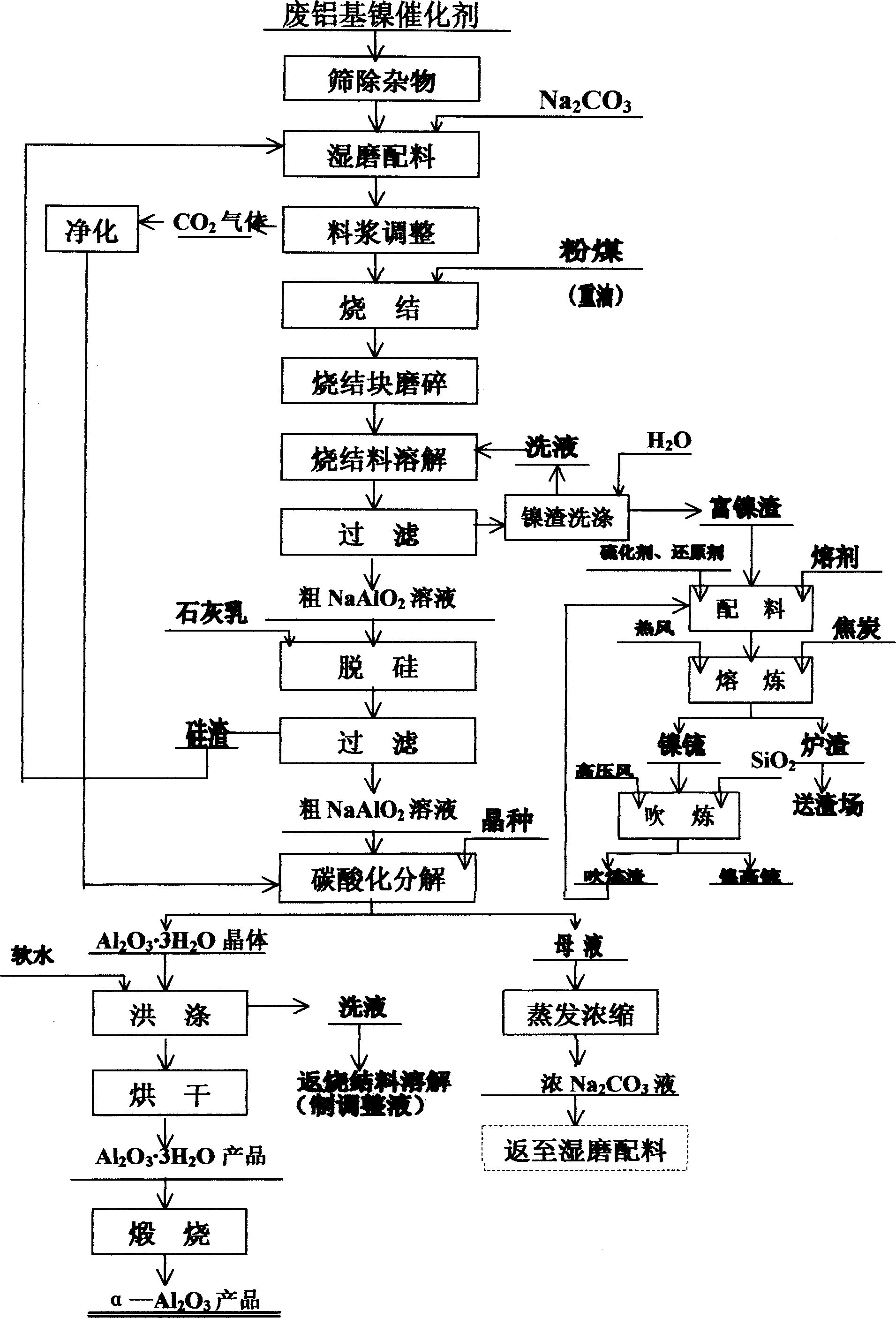Method for recovering nickel and aluminum from waste aluminum based nickel-containing catalyst
A nickel catalyst and aluminum-based technology is applied in the field of recovering nickel and aluminum from waste aluminum-based nickel-containing catalysts, and can solve the problems of unutilized, difficult filtration, and unsuitable for smelting and trapping treatment.
- Summary
- Abstract
- Description
- Claims
- Application Information
AI Technical Summary
Problems solved by technology
Method used
Image
Examples
Embodiment 1
[0057] Φ16×Φ6mm tile-gray Raschig ring-shaped waste catalyst crushed material 1000g, content α-Al 2 o 3 49.20%, Ni11.40% (NiO14.5%), SiO 2 2.0%, CaO14.80%; (1) at temperature 1100 ℃~1150 ℃, spent catalyst: sodium carbonate (weight ratio)=1: 1 condition, in SX 2 -12-10 sintering reaction in a box-type resistance furnace for 3 hours to obtain 1787 grams of sintered material, with a yield of 85.10%; (2) dissolve the sintered material with boiling water, and the ratio of the weight of the sintered material in grams to the volume of boiling water in milliliters is 1 : 4, the temperature is the boiling temperature of water, and the time is 1 hour. The nickel slag is washed with hot water for 2 times and then dried. The nickel slag weighs 472 grams, the grade Ni24.12%, Al 2 o 3 20.92%; based on nickel slag composition, Al 2 o 3 The dissolution rate is 79.93%, and nickel enrichment is 2.1 times.
Embodiment 2
[0059] 200 kg of light blue waste residue after extracting molybdenum and vanadium from spent catalyst containing nickel, aluminum, molybdenum and vanadium, content Al 2 o 3 64.96%, Ni4.64% (NiO5.89%), V 2 o 5 1.50%, MoO 3 0.20%, SiO 2 1.5%, Na 2 O and Fe 2 o 3 Trace; (1) waste slag is oven dry, and the powder after pulverizing is sintered in 5 batches in the aforementioned coal-fired heating furnace, 40 kilograms of feeding intake each time, temperature 1000 ℃~1050 ℃, waste slag: sodium carbonate (weight ratio )=1:1~1.25, sintering reaction 4~6 hours, obtain 336.4 kilograms of sintered material altogether, output rate 82.05%; 40 kg of sintering powder is put in at a time, the weight of sintering material in kilograms and the volume of boiling water in liters are 1:4-6, the temperature is the boiling temperature of water, and the time is 1 hour. The nickel slag is washed twice with hot water in the same proportion. Obtain 72.7 kilograms of nickel slag, its composition ...
Embodiment 3
[0061] Take 1 kg of nickel-rich slag with a nickel grade of 10.83%; use gypsum ore as a vulcanizing agent, containing CaSO 4 2H 2 O87.51%; blowing slag in smelters is used as flux, and its composition is FeO66.23%, SiO 2 23.05%; pulverized coal is used as reducing agent; batching ratio: nickel-rich slag: gypsum ore: blowing slag: pulverized coal=1 kilogram: 0.3 kilogram: 2 kilogram: 0.03 kilogram, with above-mentioned melting and crucible at 1300 ℃~1350 ℃, After smelting for 1.5 hours, 0.367 kg of nickel matte was obtained, the grade was 27.80% Ni, 2.8 kg of slag, containing 0.18% Ni, and the nickel smelting recovery rate was 94.21%.
PUM
 Login to View More
Login to View More Abstract
Description
Claims
Application Information
 Login to View More
Login to View More - R&D
- Intellectual Property
- Life Sciences
- Materials
- Tech Scout
- Unparalleled Data Quality
- Higher Quality Content
- 60% Fewer Hallucinations
Browse by: Latest US Patents, China's latest patents, Technical Efficacy Thesaurus, Application Domain, Technology Topic, Popular Technical Reports.
© 2025 PatSnap. All rights reserved.Legal|Privacy policy|Modern Slavery Act Transparency Statement|Sitemap|About US| Contact US: help@patsnap.com

